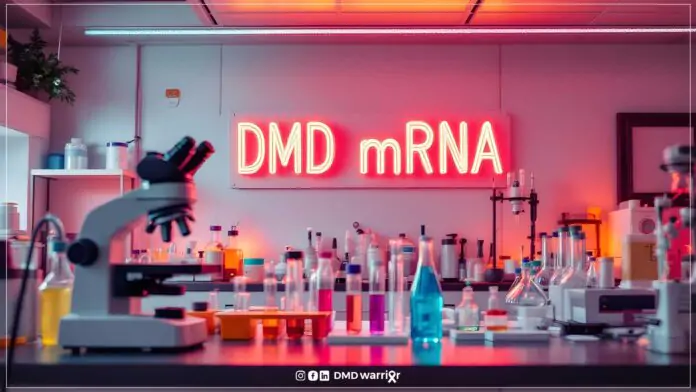Given that FDA-approved exon skipping therapies and gene therapy for Duchenne Muscular Dystrophy, which are known to not produce sufficient levels of dystrophin and thus do not completely eliminate Duchenne Muscular Dystrophy (DMD). Over the years, treatment options for DMD have been limited, but a promising area of research has emerged with the use of mRNA technology. These studies may enable production of full-length and normal dystrophin for DMD disease.
Although exon skipping cures and gene therapy have recently been approved by the US Food and Drug Administration (FDA), none of these are thought to completely cure DMD, and there remains an urgent need to create methods that restore myofiber integrity, reverse the loss of muscle regenerative capacity, and address mitochondrial dysfunction, none of which are offered by current treatments.
About 1 in 5,000 male newborns are affected by DMD, one of the most severe muscle degeneration illnesses. It is brought on by mutations in the X chromosome-related dystrophin gene. Young males with DMD experience gradual muscular degeneration, inflammation, fibrosis, and eventually pass away from heart and respiratory failure. (What is Duchenne)
Table of Contents
mRNA Studies for DMD Treatment
mRNA-based therapies are making significant strides in treating genetic diseases, including DMD. The success of mRNA vaccines in combating the COVID-19 pandemic has brought renewed attention to this approach, and researchers are now exploring how mRNA can be used to address the root cause of DMD. The goal is to use mRNA to instruct cells to produce functional versions of dystrophin or its truncated forms, potentially halting or even reversing the disease’s progression.
While mRNA-based therapies for DMD are still in the experimental phase, early results from clinical trials are encouraging. These therapies offer hope for not only halting the progression of the disease but also improving the quality of life for individuals living with DMD. As research continues and new treatments are developed, mRNA could play a pivotal role in transforming the landscape of DMD care, offering a new avenue for families affected by this debilitating disease.
Bobcat mRNA (Elixirgen Therapeutics)
Recently, Bobcat mRNA(TM), an mRNA with a proprietary 5′- and 3′-UTR design created by Elixirgen Therapeutics, made it possible to successfully generate mRNA encoding a full-length human dystrophin protein (mRNA-DMD). By introducing mRNA-DMD into human cells that were cultivated, the company initially showed that a human dystrophin protein could be produced in vitro. (Bobcat mRNA)
Elixirgen researchers have also injected mRNA-DMD into the skeletal muscles of BALB/c mice to demonstrate the synthesis and appropriate localization of a human dystrophin protein in skeletal muscles. Last but not least, a grip strength meter has been used to convincingly show the functional recovery of muscle strength in D2.mdx mutant mice, a mouse model for Duchenne muscular dystrophy.
The research initially demonstrated that six weekly injections of mRNA-DMD into the forearm muscles restored the forearm’s peak muscle strength to that of wild type DBA/2 mice. It subsequently demonstrated that D2.mdx mutant mice could regain their muscle strength after only one injection of mRNA-DMD into the forearm muscles.
According to the results, the DMD proteins that were generated were stable and stayed in the injection site for a minimum of three weeks. There were no safety findings linked to the injection or the treatment for the group that received mRNA-DMD injections. As a potential alternative to the existing treatments for Duchenne muscular dystrophy, these findings raise the prospect of delivering an mRNA encoding a full-length human dystrophin for local and eventually systemic muscle therapy. (Elixirgen Therapeutics)
AUF1 mRNA Binding Protein (Regerna Therapeutics)
In recent years, one of the most fascinating aspects of muscle molecular biology has been the control of muscle regeneration at the level of mRNA translational control.
Understanding how mRNA binding proteins regulate satellite cell mRNA translational control—which has been demonstrated to be crucial for maintaining skeletal muscle in mice—was the focus of a study conducted in the Schneider lab.
By boosting satellite cells’ ability to regenerate muscle and encouraging the development of functional muscle, the RNA binding protein AU-factor 1 (AUF1) was found to stop muscle loss.
In order to restore myofiber integrity, regeneration, and mitochondrial biogenesis, it was found that AUF1 gene therapy could functionally substitute dystrophin and significantly boost the production of utrophin, the dystrophin homolog.
This work led to the signing of a research agreement with REGENXBIO for the development of an investigational novel medication for AUF1 supplementation, which will run from March 2021 to September 2023. REGENXBIO demonstrated trust in the superiority of AUF1 in supporting poor muscle regeneration and function by providing almost $2 million in support. (Regerna Therapeutics)
DMD ANKA (mRNA Study in Turkiye)
DMDWarrioR got contact with the pharmacologist who led the team in Turkiye. The associate professor, who shared detailed information with us, requested that his name and the name of his university not be shared on our website at this time, and stated that his research continues confidentially. (DMD WarrioR’s Turkish Representative Shares His Views on Elevidys)
According to the information we received from him, the results of the mRNA study for the treatment of Duchenne Muscular Dystrophy are promising.
Results from animal trials confirmed that full-length and normal dystrophin was produced.
He stated that they have come to the end of the experimental processes so that human trials can begin in a very short time.
Key Findings from mRNA Study in Turkiye
- There is no intervention in DNA in the study.
- Production of full-length and normal dystrophin was achieved.
- It is thought to be applicable to patients with BMD and DMD.
- It can be applied to all DMD patients regardless of age.
- No negative side effects were observed in the tests performed.
- The first two doses are planned to be given 15 days apart, and the other doses are planned to be given every 6 months.
- If the second trial yields similar results, human trials will begin as soon as possible.
Conclusion
The rise of mRNA studies in Duchenne Muscular Dystrophy represents a transformative shift in how genetic disorders might be treated in the future. As technology continues to improve and our understanding of mRNA applications deepens, the potential for breakthroughs in treating DMD becomes increasingly tangible. Early results from clinical trials and ongoing research suggest that mRNA-based therapies may hold the key to slowing or even reversing the devastating effects of this disease.
For families and individuals affected by DMD, the ongoing studies offer a ray of hope. While there is still much work to be done, the rapid pace of advancements in mRNA research underscores the growing potential to develop new therapies that can drastically improve the prognosis for DMD patients. As the field of mRNA-based medicine continues to evolve, the dream of providing a cure for Duchenne Muscular Dystrophy may one day become a reality.



